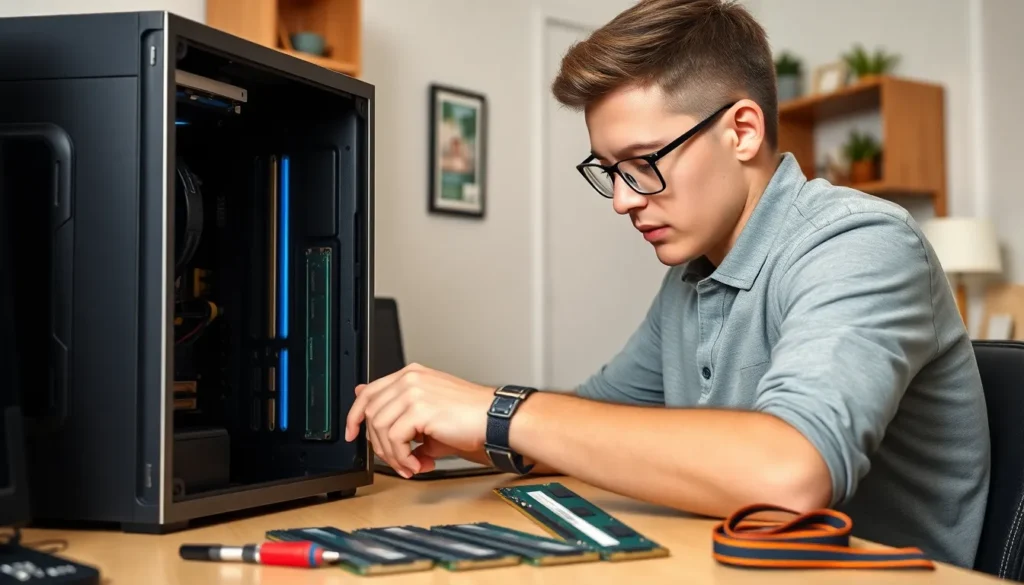Table of Contents
ToggleUpgrading desktop memory can breathe new life into an aging computer, transforming sluggish performance into smooth efficiency. As software demands grow, users often find their systems struggling to keep up. A memory upgrade not only enhances multitasking capabilities but also improves overall responsiveness, making it a smart investment for anyone looking to extend their machine’s lifespan.
Understanding the basics of desktop memory—like types, compatibility, and installation—can seem daunting. However, with the right guidance, it’s a straightforward process that can yield significant benefits. Whether it’s for gaming, graphic design, or everyday tasks, optimizing memory is key to achieving peak performance and ensuring a seamless user experience.
What Are Desktop Memory Upgrades?
Desktop memory upgrades involve increasing the RAM (Random Access Memory) capacity of a computer. RAM acts as a temporary storage space for data that the CPU needs to access quickly. Upgrading RAM boosts a system’s ability to handle multiple tasks, enhancing performance for activities like gaming, graphic design, and data processing.
Various types of desktop memory exist, including DDR4 and DDR5 modules. These types differ in speed and efficiency, so a compatible upgrade is essential. Compatibility involves matching the RAM type, speed, and size with existing components, as incompatible upgrades can lead to performance issues or system instability.
Installation of desktop memory upgrades is generally straightforward. Users typically follow these steps:
- Turn off the computer: Always disconnect power before opening the case.
- Open the computer case: Access the motherboard where the RAM slots are located.
- Locate the RAM slots: Existing modules may need removal if all slots are occupied.
- Insert new RAM modules: Align the notch on the RAM with the slot, pressing firmly until seated.
- Close the case and power on: Check system recognition of the new RAM through the BIOS or operating system.
Investing in desktop memory upgrades can extend a computer’s lifespan while significantly improving its multitasking capabilities and overall responsiveness.
Benefits of Upgrading Desktop Memory

Upgrading desktop memory offers several advantages that significantly improve system performance and user experience. Increased RAM capacity leads to notable gains in speed and efficiency for various computing tasks.
Improved Performance
Improved performance surfaces through enhanced data processing speeds and reduced load times. Systems with upgraded RAM can handle demanding applications, such as video editing and 3D rendering, with greater fluidity. Benchmarks show that memory upgrades can lead to performance boosts of 20% to 50% in many scenarios. Users notice faster boot times and smoother operation, especially when running resource-intensive programs or games.
Enhanced Multitasking
Enhanced multitasking capabilities arise from a larger pool of available memory. With additional RAM, users can run multiple applications simultaneously without experiencing slowdowns. This capacity allows for seamless switching between tasks, significantly improving productivity. For instance, users can browse the web, stream videos, and work on documents concurrently. Studies indicate that systems with upgraded memory can manage three to four times more active applications than those with insufficient RAM.
Types of Desktop Memory
Desktop memory comes in various types, primarily focusing on DDR4 and DDR5. Understanding these types and their compatibility ensures optimal performance during upgrades.
DDR4 vs. DDR5
DDR4 and DDR5 represent the two most common types of desktop memory.
- DDR4: Released in 2014, DDR4 supports speeds ranging from 2133 MT/s to 3200 MT/s. It utilizes a 288-pin connector and operates at a lower voltage of 1.2V, contributing to improved energy efficiency.
- DDR5: Introduced in 2020, DDR5 offers higher speeds, starting at 4800 MT/s and exceeding 8400 MT/s. Its 288-pin design, similar to DDR4, allows for increased bandwidth and enhances performance in memory-intensive tasks. Additionally, it operates at a lower voltage of 1.1V, further improving power efficiency.
Choosing between DDR4 and DDR5 often depends on system requirements, as DDR5 typically provides better performance but also comes at a higher cost.
Compatibility Considerations
Compatibility is crucial when upgrading memory.
- Motherboard Support: Verify motherboard specifications for supported memory types. Mismatched types can lead to system instability or failure to boot.
- RAM Speed: Consider the maximum speed supported by the motherboard, as using faster RAM than the motherboard can handle often results in downclocking to the maximum supported speed.
- Memory Capacity: Check the maximum capacity allowed by the motherboard. Installing more RAM than the operating system or motherboard can support leads to wasted investment.
- Dual Channel Mode: Use compatible pairs of RAM for dual-channel operation, which significantly enhances performance. Matching speed, capacity, and timings between modules ensures better compatibility.
Prioritizing these compatibility factors ensures a successful upgrade and maximizes the benefits of increased desktop memory.
How to Choose the Right Memory Upgrade
Selecting the correct memory upgrade requires consideration of several key factors. Understanding specifications such as capacity, speed, and brand ensures optimal performance for the system.
Capacity and Speed
Capacity and speed are primary factors in choosing desktop memory. Capacity refers to the amount of RAM measured in gigabytes (GB); common sizes include 8GB, 16GB, and 32GB. Upgrading to at least 16GB is often recommended for gaming and intensive applications, while 32GB or more benefits graphic design and video editing tasks.
Speed, measured in megatransfers per second (MT/s), influences how quickly data is processed. DDR4 typically ranges from 2133 MT/s to 3200 MT/s, while DDR5 starts at 4800 MT/s and can exceed 8400 MT/s. Opt for the highest supported speed that the motherboard can utilize to enhance overall performance. Always balance capacity and speed for optimal results, ensuring that both meet the demands of the intended applications.
Brand Recommendations
Choosing a reputable brand enhances reliability and performance. Established brands like Corsair, G.Skill, Crucial, and Kingston offer a range of memory products recognized for quality and performance. Look for products with good reviews and solid warranties, as these often indicate reliability.
Consider dual-channel or quad-channel kits to maximize bandwidth, as these can improve data transfer rates, allowing smoother multitasking. It’s essential to verify compatibility not just with the motherboard, but also between different brands, especially when mixing existing and new memory modules.
Installation Process for Memory Upgrades
Upgrading desktop memory involves a straightforward installation process. With the right tools and preparation, the upgrade can proceed smoothly and efficiently.
Tools and Preparation
Gather significant tools and supplies to simplify the memory upgrade. Ensure access to:
- Antistatic Wrist Strap: Prevents electrostatic discharge damage to components.
- Phillips Screwdriver: Needed to open the computer case and secure RAM modules.
- Soft Cloth or Anti-Static Mat: Protects delicate components from scratches or static.
- New RAM Modules: Choose compatible memory based on previous guidance regarding types and specifications.
Prepare a clean, well-lit workspace. Disconnect power cables and peripherals from the computer for safety. Verify that the new RAM is compatible by consulting the motherboard manual or manufacturer’s website.
Step-by-Step Guide
Follow this step-by-step guide for a successful memory installation:
- Turn Off the Computer: Ensure complete shutdown, unplug the power cable, and disconnect peripherals.
- Open the Case: Remove screws securing the case panel or release latches, depending on the design.
- Locate RAM Slots: Identify the existing RAM slots on the motherboard. Often, they are located near the CPU.
- Remove Old Modules (if necessary): Release the clips at both ends of the RAM slot to remove any existing modules, if required.
- Insert New Modules: Align the notches on the new RAM with the grooves in the slots. Firmly press down until the clips click into place.
- Check Seating of Modules: Ensure RAM is securely seated by checking that the clips hold the modules in position.
- Close the Case: Reattach the case panel by securing screws or re-engaging latches.
- Reconnect Power and Peripherals: Plug in the power supply and reconnect other external devices.
- Boot Up the Computer: Start the system and enter the BIOS/UEFI to verify that the new RAM is recognized.
- Check System Recognition: Confirm the operating system recognizes the new RAM capacity via the system properties.
By following these steps, users can effectively upgrade their desktop memory and enhance system performance.
Upgrading desktop memory is a smart way to breathe new life into an aging computer. By enhancing RAM capacity users can experience smoother multitasking and faster performance for demanding applications. Whether it’s for gaming graphic design or everyday tasks the benefits are clear.
When considering an upgrade it’s essential to prioritize compatibility and choose the right memory type. With straightforward installation steps and careful planning anyone can successfully boost their system’s capabilities. Investing in desktop memory not only improves performance but also extends the overall lifespan of the computer.




